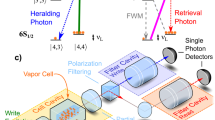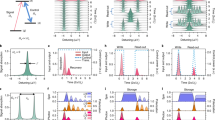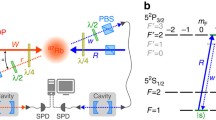Abstract
In this paper, we demonstrate numerically that we can create a potential-well-like ultrahigh-Q nanocavity to trap a traveling signal pulse with a long storing time. This approach has potential application in photon memories and quantum computing.
You have full access to this open access chapter, Download conference paper PDF
Similar content being viewed by others
1 Introduction
At present, there are already many methods to constructing a high-Q microcavity, which are basically achieved by partially modifying the mode gap or by constructing a whispering gallery [1,2,3,4,5,6,7,8]. However, we cannot design our structure which need to achieve light movement based on these traditional methods because the high-Q microcavities formed by these methods are fixed in one place and cannot be moved [9,10,11,12,13]. For this reason, we designed a method based on local refractive index increasing on a photonic slab to form a high-Q nanocavity realized by local mode gap modification. Our structure is based on the W1 line-defect waveguide in a 2D triangular air-hole dielectric photonic crystal slab shown in Fig. 47.1a. We increase the refractive index of the dielectric material in the rectangular shaded area in Fig. 47.1b, while the refractive index of the air hole remains unchanged. Through this process, the area refractive index increased forms a potential well, which can confine the light so that a high-Q microcavity is formed. The high-Q nanocavity formed by this method is reversible because we have not made any permanent change on the structure like move the air holes or fill some air holes, and the refractive index increasing which can be receive by fast optical nonlinear processes like Kerr nonlinearity is reversible so that we can use this method of dynamic modulation to make high-Q nanocavity very flexible and can be constructed at any time and at any position on the waveguide. When we do not modulate, the whole structure is a simple waveguide structure, the waveguide mode introduced by line defects can propagate freely in the waveguide.
In this paper, we propose a simple method for realizing ultrahigh-Q nanocavities which can be formed instantly at any time and at any position in a PC waveguide and can be moved on demand. We also apply this method to light storage.
2 Model
We start by considering a triangular-lattice PC slab as shown in Fig. 47.1a. The refractive index of this silicon slab is n0 = 3.4. The lattice constant a, the radii of air holes r, and the thickness of the slab h are 420 nm, 110 nm, and 210 nm, respectively. A W1 line-defect waveguide is formed by removing a row of air holes, as shown by Fig. 47.1b. If we increase the refractive index of the waveguide region slightly, the mode curve will descend a little, as shown by the dashed lines in Fig. 47.1b. Thus, we can form a potential well to trap the photons through altering the refractive index in waveguide local region. With the help of the mode gap, the walls of the formed potential well can act as perfect mirrors to form an ultrahigh-Q nanocavity. When no modulation, the whole system is a simple PC waveguide structure, and the waveguide modes introduced by line defects can propagate freely along the waveguide.
To trap and store signal photons, we suppose in the beginning, a signal light pulse is injected into a W1 PC waveguide from the input end. Since at present this simple PC slab has no resonator, the injected signal pulse will travel down the waveguide freely. When we want to trap this signal light, just swiftly increasing the refractive index of the local region in the waveguide to form a potential-well-like cavity. In this way, the signal photons will be trapped and stored by the dynamically-formed nanocavity.
3 Application
We perform finite-difference time-domain (FDTD) simulations [14] on the PC structure shown in Fig. 47.2a. The length of the PC waveguide is set to be 87a. When a sudden index variation of Δn/n0 = 0.8% is added to the dielectric material of the modulation area, a potential-well-like nanocavity will be dynamically formed. FDTD simulations show that the resonance wavelength of the formed cavity is λ0 = 1683.14 nm, and the Q factor is calculated to be ~12,000,000 by an exponential fit of the electromagnetic energy decay. These results confirm that the mechanism for dynamically generating an ultrahigh-Q nanocavity is feasible and efficiency, without any spatial structure tuning.
This dynamically formed ultrahigh-Q nanocavity offers us a new opportunity to make the manipulation on photons flexible. The signal light is a long light pulse with a wavelength of 1668 nm which is close to the edge of the wavelength of the mode induced by the line defect. The light pulse injects our structure from the left side of the waveguide, which is shown as the red arrow in Fig. 47.2a, and propagates along the waveguide to the right end. At t = 13 ps, the signal light pulse reaches the center of the waveguide, and we begin to modulate the rectangular shaded area to increase the refractive index of dielectric material to 1.008n. It can be seen from field distribution snapshots in Fig. 47.2b–e that the signal light is captured by the region increased refractive index, stays at the center of the waveguide, and the light density can be well reserved even after a long time. The frequency of the captured light in the refractive index modulated area is 1683.14 nm, which is exactly the resonant frequency of the microcavity, proving that the captured light intensity exists as the resonant mode of the microcavity, so its energy decay rate is very small, and it can stay in this region for a very long time. This can also be confirmed from Fig. 47.2, which shows the magnetic field strength monitored in the center of the waveguide as a function of time. When we start to increase the refractive index of the rectangular shaded area at t = 13 ps, the magnetic field strength begins to fluctuate sharply, and at a segment of time after this, a large part of the light intensity captured by the refractive index increased region and finally exist as the resonant mode of the formed high-Q nanocavity. It can be seen that the decay speed of the captured signal light intensity is very slow, which make the captured light can be held for a long time.
Above we showed how to capture signal light through dynamic modulating the refractive index on a rectangular area of a 2D triangular air-hole dielectric photonic crystal slab with W1 line-defect waveguide. In the following, we will show how to achieve controllable light movement through dynamic refractive index modulation on our structure, using the flexibility of the high-Q microcavity we formed. After the light capture process, the signal light has been fixed at the center of the structure, where the rectangular shaded area is located. Then, at t = 50 ps, we start to move the rectangular refractive index modulation region (the refractive index of the dielectric material on area newly covered by the moving rectangular area increase to 1.008n, and the refractive index on area no longer been covered return to n) with a constant speed of 0.15c. The region finally reaches a place, which is 26a away from the starting position.
We found the captured signal light originally stayed at the center of the whole structure which is exactly the position the rectangular shaded region is located. Then, when t = 50 ps, the refractive index modulation region begins to move, and the captured signal light move along with the movement of the region, that is, toward waveguide moves to the right, with a speed almost the same as the speed of the movement of the region, and finally reaches and stays where the rectangular shaded area stays. As a result, we realized the controllable light movement by using the flexibility of the high-Q microcavity we formed, which used a dynamic refractive index modulation method.
4 Conclusions
In summary, we have demonstrated numerically that we can create a potential-well-like ultrahigh-Q nanocavity to trap a traveling signal pulse with a long storing time. This approach has potential application in photon memories and quantum computing.
References
K. Nozaki, A. Shinya, S. Matsuo, Y. Suzaki, T. Segawa, T. Sato, Y. Kawaguchi, R. Takahashi, M. Notomi, Ultralow-power all-optical RAM based on nanocavities. Nat. Photon. 6, 248 (2012)
L. Fan, J. Wang, L.T. Varghese, H. Shen, B. Niu, Y. Xuan, A.M. Weiner, M.H. Qi, An all-silicon passive optical diode. Science 335, 447 (2012)
D.L. Sounas, J. Soric, A. Alù, Broadband passive isolators based on coupled nonlinear resonances. Nat. Electron. 1, 113
K. Hennessy, A. Badolato, M. Winger, D. Gerace, M. Atatüre, S. Gulde, S. Fält, E.L. Hu, A. Imamoğlu, Quantum nature of a strongly coupled single quantum dot–cavity system. Nature 445, 896 (2007)
B.-S. Song, S. Noda, T. Asano, Y. Akahane, Ultra-high-Q photonic double-heterostructure nanocavity. Nat. Mat. 4, 207–210 (2005)
B.-S. Song, T. Asano, S. Noda, Physical origin of the small modal volume of ultra-high-Q photonic double-heterostructure nanocavities. New J. Phys. 8, 209 (2006)
Y. Akahane, T. Asano, B.-S. Song, S. Noda, High-Q photonic nanocavity in a two-dimensional photonic crystal. Nature 425, 944 (2003)
K. Ashida, M. Okano, M. Ohtsuka, M. Seki, N. Yokoyama, K. Koshino, M. Mori, T. Asano, S. Noda, Y. Takahashi, Ultrahigh-Q photonic crystal nanocavities fabricated by CMOS process technologies. Opt. Express 25, 18165 (2017)
Y. Lai, S. Pirotta, G. Urbinati, D. Gerace, M. Minkov, V. Savona, A. Badolato, M. Galli, Genetically designed L3 photonic crystal nanocavities with measured quality factor exceeding one million. Appl. Phys. Lett. 104, 241101 (2014)
Z.-M. Xu, C. Li, J.-F. Wu, Dynamic trapping and releasing photonics beyond delay-bandwidth limit in cascaded photonic crystal nanocavities New J. Phys. 22, 063030 (2020)
Y. Tanaka, J. Upham, T. Nagashima, T. Sugiya, T. Asano, S. Noda, Dynamic control of the Q factor in a photonic crystal nanocavity. Nat. Mater. 6, 862 (2007)
J. Upham, Y. Tanaka, T. Asano, S. Noda, Dynamic increase and decrease of photonic crystal nanocavity Q factors for optical pulse control. Opt. Express 16, 21721 (2008)
B. Wang, J.-F. Wu, C. Li, Z.-Y. Li, Dynamic tuning of the Q factor in a photonic crystal nanocavity through photonic transitions. Opt. Lett. 43, 3945 (2018)
A. Taflove, S.C. Hagness, Computational Electrodynamics (Artech House, 2000).
Acknowledgements
This research was financially supported by the National Natural Science Foundation of China (11774098); Guangdong Natural Science Foundation (2017A030313016); Science and Technology Program of Guangzhou (202002030500).
Author information
Authors and Affiliations
Corresponding author
Editor information
Editors and Affiliations
Rights and permissions
Copyright information
© 2022 The Author(s), under exclusive license to Springer Nature Singapore Pte Ltd.
About this paper
Cite this paper
Chen, JH., Li, C., Wu, JF. (2022). Trapping and Storing Photons via a Dynamically-Formed Nanocavity. In: Liu, G., Cen, F. (eds) Advances in Precision Instruments and Optical Engineering. Springer Proceedings in Physics, vol 270. Springer, Singapore. https://doi.org/10.1007/978-981-16-7258-3_47
Download citation
DOI: https://doi.org/10.1007/978-981-16-7258-3_47
Published:
Publisher Name: Springer, Singapore
Print ISBN: 978-981-16-7257-6
Online ISBN: 978-981-16-7258-3
eBook Packages: Physics and AstronomyPhysics and Astronomy (R0)






